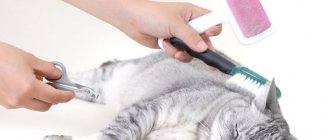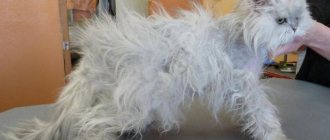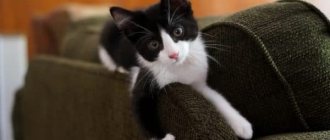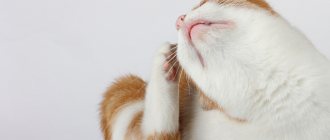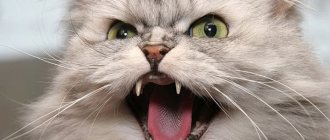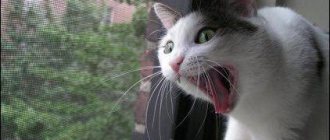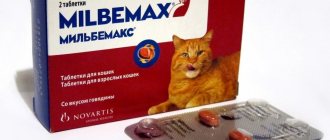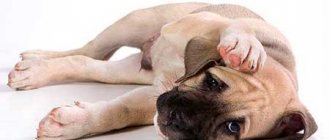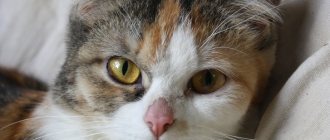Home » Useful Information
Many cat breeders know first-hand what mats are. These nasty hairballs appear quite quickly in some cats. Therefore, it is easier to find out once what to do to prevent and eliminate them than to constantly contact veterinarians to trim the animal.
- 2 What danger lies in matted fur?
- 3 Tools for removing tangles
3.1 Photo gallery: tools for removing cat mats
- 4.1 Video: in a veterinary clinic, a cat’s mats are cut with a clipper
- 5.1 Photo gallery: shampoos for long-haired cats
What are mats?
The fur of cats, especially long-haired breeds, requires careful care. With a lack of hygiene, poor nutrition and other mistakes when keeping pets, their fur begins to deteriorate. This affects not only appearance, but also health.
Older pets cannot provide themselves with the same careful care as younger pets. The wool begins to get tangled, matted, and tangles form. However, young age is not a guarantee that lumps will not appear.
What are tangles
Lost hairs that remain on the cat's body can become tangled with each other, with growing hairs, and form into dense lumps - tangles.
Basically, the cat's undercoat falls off - the lower layer of hair, which is responsible for thermoregulation. In long-haired breeds such as Siberian, Maine Coon, Norwegian Forest, Persian, Angora, Neva Masquerade, the undercoat is highly developed. These breeds require regular brushing.
First, lumps form in the armpits, inner thighs, and groin - where friction occurs during movement. Then on the stomach, back, tail, behind the ears. When neglected, the hair clumps together, covering almost the entire body. There is also a risk of getting a complete ball of felt when the owner tries to bathe a cat whose fur is matted.
Causes
If pets are healthy and can take care of their hygiene, they usually do not develop tangles. However, there are cat breeds with fluffy fur and thick undercoat that are prone to ball formation. These include Persians, British, Turkish Angora and others.
Not all long-haired breeds suffer from mats. For example, Siberian cats and Maine Coons rarely develop lumps. Mainly in places of thick and wavy undercoat (on the “collar”, “pants”).
Mats on wool appear for the following reasons:
- the pet is rarely or not brushed at all;
- during the molting period, the animal’s old fur is not combed out;
- the pet is sick;
- the cat is washed with an incorrectly selected shampoo; when soaping, the fur becomes very crumpled, which is why dense clumps are formed;
- the cat is lazy and fat, obese;
- the pet does not eat rationally, which is why it may develop vitamin deficiency (the fur becomes very loose and the risk of lumps forming increases);
- sticky substances (for example, jam, honey, paint, etc.) have come into contact with the fur;
- pathological conditions develop: oncology, parasites, dermatitis, endocrine disorders.
If a pet develops tangles, the owner is to blame. This means he did not take good care of the animal.
Why does a cat have mats?
When breeding long-haired breeds, the emphasis was placed on the properties of the coat. Cats with particularly thick and long fur were selected for breeding. Animals are sometimes unable to take care of such “fur coats” using only their paws and tongue. Therefore, there are often cases when, due to lack of care for long-haired felines, the hair becomes matted and forms tangles. Cutting out the formed lumps is not a problem, but it is better not to bring the animal to such a state.
What usually causes mats in cats:
- poor quality nutrition with a lack of vitamins and minerals;
- the presence of dandruff, which thickens the tangles and makes it impossible to comb the hair;
- using inappropriate cleaning products when bathing, such as using shampoos intended for humans;
- improper soaping during bathing and drying after it;
- fur contamination that the cat cannot cope with on its own (grease, chemicals, etc.);
- diseases: the fur first reacts to the animal’s poor health;
- parasitosis.
The hairline is renewed cyclically. Some hair falls out every day, and new ones grow in their place. If the fallen hairs are not removed in time, a hairball will form, that is, a tangle. It can form anywhere, but most often it appears behind the ears, on the tail, on the neck, in the groin or armpits. Even short-haired cats are susceptible to matting, although this does not happen often. Usually this situation is preceded by poor health or severe soiling of the coat.
Why are they dangerous?
The appearance of matted fur spoils the appearance of the animal. This is a huge disadvantage for a breeder of purebred cats. In addition, petting a pet with mats is unpleasant.
However, these are not the worst consequences. Mats can provoke the development of various diseases. Pathogenic microorganisms begin to multiply in matted wool. When a pet licks itself, they enter the body and continue their synthesis there.
Fleas, lice, ticks and other parasites take root well in tangles. The skin under the lumps becomes rotten, dermatological problems arise that are difficult to treat. In addition, the cat will try to independently remove matted fur with its claws, and in the process may cause wounds to itself. Such damage will take a long time to heal.
How to get rid of mats in cat fur
Depending on the degree of damage to the hair, you can try to disassemble and comb out the tangles. In cases where this is impossible, it is better to completely trim the pet.
Combing out trichomes begins with parsing the affected area. It is better to first lightly moisten the animal’s fur with a spray bottle or, if the animal is afraid, with your hands. Carefully, without making sudden movements and without hurting the cat, try to separate the matted fur with your fingers.
Then, holding the tangle at the base, try to comb the hair with frequent movements, gradually moving from the ends of the hair to its roots. It is better to use a fine-toothed comb for this.
If the trichome is too dense, it should be cut. To do this, you can use a special device, a welt cutter, or do it with scissors.
The mat is cut along the hair into several parts, each of which is disassembled and combed out separately. If combing is not enough, individual tangled areas of fur can be carefully cut off, being careful not to damage the animal's skin. It is better to carry out a full haircut in a salon or veterinary clinic, after first immobilizing the cat with a sedative.
Removal methods
Tangles are removed from wool in the following ways:
- If the lumps are small, you can comb them out. The pet should be placed on its side and stroked. This is necessary so that he calms down and does not break out. First, comb the sides and back, neck and chest, forelimbs, tail. It is more difficult to get rid of tangles on the stomach and hind legs. Most likely the animal will bite.
- Large clumps are recommended to be cut lengthwise and then combed.
- If there are a lot of tangles, it is completely impossible to comb them out, then the tangled hair will have to be cut to the ground. You need to be very careful: a cat’s skin is thin and can be easily damaged. Clumps can be removed with scissors, people clippers or hair clippers. The receding hairline will heal after a few months.
- At the pet store you can purchase a special device called a tangle cutter. This is a comb with blunt ends, blades between the teeth.
- You can take your cat to a veterinarian or pet groomer. There your pet will be trimmed at an affordable cost.
- To deal with long unnecessary hair, there is a special comb - a furminator. Not only will it help get rid of clumps, but it will also be an indispensable tool for daily combing.
Can mats harm an animal?
Owners often underestimate the problem, not realizing that mats in cats can cause serious consequences:
- matted hair causes pain in the cat. The animal, trying to get rid of the problem, becomes nervous and irritable, worries, eats and sleeps poorly. This negatively affects the general condition of the pet;
- the undercoat falls tightly and close to the skin, so natural ventilation is disrupted. Because of this, heat exchange changes and in warm weather the animal may suffer from overheating, and in cold weather it may freeze, since the wool knocked into balls provides almost no warmth;
- constant companions of tangles are skin diseases in the form of eczema and dermatitis. Severe forms of these diseases can lead to the death of the pet.
Regardless of the number and size of tangles, this process cannot be ignored. Tangled areas of fur must be removed and this must be done correctly.
Rules for removing mats in cats
Recommendations for removing mats:
- The process of eliminating lumps is long. Most likely, your pet will not like it. The pet will not give in and will start fighting. Therefore, it is better to comb out tangles together: one person holds the cat, the other combs it. If the animal is very nervous, then it is better not to traumatize its psyche and get rid of the matted fur not at once, but several times.
- Only areas with long hair are clipped. It is better not to touch the paws and head. It's okay if your pet looks like a lion. The fur will grow back in a couple of months.
- Until the mats are removed, washing the animal is prohibited. After water, lumps are more difficult to comb out.
- After combing, treat the pet's fur with an antistatic spray. The product will detangle your hair and prevent further formation of tangles.
How to remove mats from a cat at home
The owner can tidy up the pet's fur on his own. To remove a small amount of tangles you will need:
- product for home or professional cat hair care;
- comb with sparse and non-sharp teeth;
- tangle cutter (there are different types);
- a brush or a special glove for combing.
Particular attention should be paid to the choice of products that make it easier to comb the coat. They must be hypoallergenic, suitable for a certain type of wool, and have a high-quality composition. For example, the Elite spray conditioner from the Elite Professional series with allantoin, glycerin and a complex of conditioning components is suitable. It is adapted for home use, has an antistatic effect to reduce electricity, a softening and moisturizing effect, adds shine to the animal's coat, facilitates combing and prevents tangling.
Before purchasing cosmetics and grooming tools, you should consult a specialist in the field of cat grooming.
Steps to remove tangles:
- Spray the spray onto dry hair to make combing easier.
- Gently untangle the tangles with a wide-tooth comb. If this is not possible, you need to cut off the tangles with a special tool or nail scissors with thin rounded blades.
- Gently comb the fur with a brush.
In particularly advanced cases, if the cat is aggressive and restless, it is advisable to carry out the procedure together. One person holds the pet, the second removes tangles. This will avoid injury to the animal’s skin and protect the owner from scratches. After the procedure, you should treat the cat with a treat.
If you can’t deal with your cat’s tangles on your own, it’s better to go to a grooming salon. Specialists will help you put the fur in order, if necessary, give the animal a haircut and give recommendations on proper care. A hygienic clipper cut can be done under general sedation in a veterinary clinic.
Spray conditioner "Elite" of the Elite Professional series can be used not only on dry hair, but also after washing the cat on a slightly dry coat to make combing easier. For bathing, you can choose shampoo and balm “Elite” that are suitable for your coat type - professional products for regular care. After rinsing, you need to dry the coat a little, apply conditioner spray and comb it.
Preparing an area with tangles
Sprinkle a small amount of cornstarch or talcum powder on the matted area and work it in gently with your fingers. Carefully move the fur away from the skin so that its location is visible.
If the animal resists, take a break and speak in a soothing voice, petting the cat until it relaxes. Repeat this action regularly during the procedure when your pet is nervous.
Anti-matt spray for cats - effect according to reviews
Anti-matt spray for cats is sold at different prices. A high-quality product that is safe for animals is sold for 300-500 rubles. However, in this case, you can be completely sure that the pet will not get an allergic reaction if it accidentally licks its fur after the procedure.
Sprays are designed to make combing easier. First, the lump should be separated from the main mass of wool and fixed. Then it is sprayed with a spray and wait a few minutes. The owner carefully begins to comb the animal, trying not to touch the skin.
Special sprays are also used for prevention. They spray the animal's fur after bathing and before combing. Of course, it is much easier to prevent the formation of tangles than to deal with a large number of them.
There are spray options that are even more expensive and have a better composition. Attention should be paid to the reputation of the manufacturer and individual tolerance to animals. There are even high-quality compounds that for some reason cause irritation in cats that are highly sensitive to odor.
Reasons for the formation of tangles
TO
Cat tints, or scientifically called trichomes, appear mainly in long-haired breeds. This pathological condition of the coat is characterized by the formation of matted and tangled hairs. The lump of resulting wool is so dense that it resembles thick felt fabric from the outside.
In the vast majority of cases, trichomes appear in an animal in a place that is difficult for it to reach. In these places, wool is most susceptible to mechanical friction. The location of the mats is the stomach, groin area, under the tail, on the inside of the front and hind legs, in the back and neck.
Veterinary experts associate the appearance of trichomes in long-haired cats with improper care of the cat by the owner.
In some cases, the cause of tangles is a pathological focus on the skin - a wound or ulcers, with the constant release of exudate, which provokes sticking and further matting of the hair.
In addition to the factors described above, there are a number of other reasons that can lead to the appearance of trichomes. The main ones are:
- dirty coat – dust and wet dirt cause hairs to attract and stick together;
- Stressful conditions in a cat on an ongoing basis;
- disruption of the endocrine system (hormonal imbalances leading to an imbalance in the metabolism of the skin);
- disruption of metabolic processes in the body;
- parasitic infestations - fleas, ticks and various lice-eaters;
- age of the animal - old and weakened animals cannot care for themselves properly;
- violations in the diet (acute deficiency of essential nutrients, vitamins and minerals, disrupts the general condition of the skin and coat);
- improper care of your pet’s fur (especially noticeable in breeds with long hair, since the coat is constantly changing, it needs to be combed and untangled small matted lumps, preventing the appearance of large tangles);
- excessive or irregular bathing of the cat - it is necessary to bathe the animal as needed, and after taking water procedures, it is important to properly dry and comb the fur, which will make it possible to avoid the formation of trichomes.
It is important to understand that tangles formed from wool are not only unsightly, but also indicate problems in the care or condition of the animal’s body. Disruption of metabolic processes, as well as damage to the skin by parasites or sores, also provokes the development of tangles.
It follows from this that the appearance of trichomes is a kind of signal from the body about problems in feeding or care. Due to the uncomfortable sensations that appear with tangles, the cat becomes irritated, tries to gnaw out the matted fur, tears it with its paws and can injure the delicate skin.
Against the background of damage, bacterial pathogenic microflora may appear, complicating the condition of the animal’s body.
Removal of small problematic formations
Small lumps can be easily combed out. Just calm the cat down and run a comb through the fur. The hardest part to comb is the belly and paws. The cat may struggle, so call a second person to help hold the animal in this case.
To make combing easier, special antistatic sprays are purchased; of course, each breed requires its own high-quality cosmetic product.
Use a spray for easy combing
Lumps that are slightly larger are cut lengthwise, cut into several pieces, and only then untangled either by hand or combed out with a comb. This procedure is done very carefully so as not to injure the cat.
